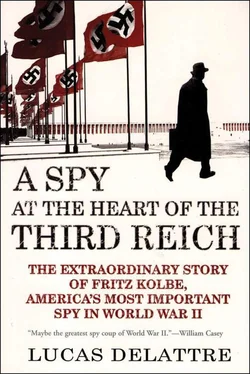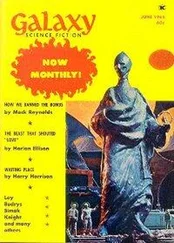Already, she was getting up to leave. Fritz managed to delay her a little longer: the form was incomplete, a letter had to go with it. She hastened to write it, but hesitated for a moment before giving it to him. “Should I sign with ‘ Heil Hitler ’?” she asked him, her pen still uncapped in her right hand. Fritz Kolbe did not answer. She looked up, worried, and encountered an almost threatening look. “Look here, don’t think of it,” he finally said, “do you know where we are?” A quick exchange of smiles and there was now complete trust between the two.
Fritz wanted to see her again. He asked Maria Fritsch whether it would be possible to make an appointment to see Professor Sauerbruch. He did a lot of sports—boxing, running, bicycling—and always felt severe pain in his knees, despite a surgery he had had in 1933. “I’ll see what I can do,” she answered, “he is swamped, but I’ll try to slip in an appointment for you.” With that, she disappeared down the corridors of the ministry.
Ferdinand Sauerbruch was a great doctor. The surgical procedures that he invented were recognized around the world. In particular, he had conceived a revolutionary method for opening a patient’s rib cage without provoking a collapse of the lungs (the patient’s torso was placed in a low-pressure chamber, while his head remained in the open air). He had also created an artificial hand that could be moved at will.
Independently of his enormous talent, Sauerbruch was to the medicine of the Third Reich what Gustav Gründgens (the man on whom Klaus Mann modeled his character Mephisto) was to the theater of the time. Like him, he probably would have emigrated and would have become a fiery antifascist “if only he had been given attractive offers abroad,” according to Klaus Mann. Instead, the professor had chosen to pursue his career in Germany as though nothing had changed. At the age of sixty-five in 1940, the “Professor Doktor” was a prince of medicine, covered with honors, not lacking in self-importance or even vanity. He was head of the largest hospital in Berlin, the Charité. He sometimes exercised his art like a chess champion, carrying on several operations at the same time in different operating theaters. He taught in amphitheaters filled with students and admirers of both sexes. He was asked for his opinions throughout Europe, and he counted several crowned heads among his patients.
Sauerbruch had never taken care of Hitler, but the dying Marshal Hindenburg had called on him for his prostate, Goebbels for his appendicitis, and Robert Ley—head of the “Labor Front,” which replaced the dissolved unions—his hemorrhoids. Sauerbruch had contacts high up in the Reich chancellery. One of the doctors closest to the führer, SS-Obersturmbannführer Karl Brandt (in charge of the euthanasia program for the mentally handicapped), was one of his former pupils. In charge of medical matters for the principal scientific institutions of the Reich, Professor Sauerbruch supported some of the worst medical experiments carried out in the concentration camps.
The Nazis needed to keep on their side major intellectual and artistic talents like Ferdinand Sauerbruch. Not affiliated with the Nazi Party, the surgeon was an emblem of respectability for the regime, which granted him great freedom of speech and action. He was a member of the prestigious “Wednesday Club,” an independent intellectual group that continued to hold regular meetings despite the war. It was one of the few forums for discussion where one could still escape from the surveillance of the Gestapo. They didn’t engage in politics at the Wednesday Club, although they did not avoid various subjects related to the present time. Among the figures who were members of the club were both the biologist Eugen Fischer, one of the major theorists of eugenics, and General Ludwig Beck, former army chief of staff, who had resigned in August 1938 to protest against Hitler’s planned invasion of Czechoslovakia.
Fritz Kolbe did not yet know, when he met Sauerbruch for the first time, how useful he would find the Charité hospital and the protected status of the surgeon.
Between Berlin and East Prussia, September 18, 1941
In the train taking him to Hitler’s headquarters in East Prussia, Fritz Kolbe read the newspapers and glanced through a few dispatches that he had to hand over the next day to the führer’s diplomatic staff. Since his departure from the Berlin-Grunewald station, he had been alone in his compartment. The car was reserved for officers and government officials headed for the front or on missions to the reserve lines. Since the beginning of the Russian campaign in June 1941, the führer’s headquarters had been in the “wolf’s lair” ( Wolfsschanze ) at the eastern edge of the country. Fritz was carrying a large quantity of documents, most of which were classified “secret Reich business” ( geheime Reichssachen, the highest level of confidentiality for the Nazis). Under no circumstances was he to be separated from the briefcase containing them. The documents were intended for his superior, Ambassador Karl Ritter, one of the highest officials in the Foreign Ministry, who was in consultation with military headquarters.
Born in Bavaria and trained as a lawyer, Karl Ritter had been the undisputed specialist for economic questions in the Foreign Ministry since the 1930s. Since the beginning of the war he had headed a key department in the ministry, political-military affairs (Pol I M). He had a typical title for the time: he was an “ambassador on special mission,” which meant that he was there to bypass on an ad hoc basis the traditional decision-making networks of the ministry. Although he was a career diplomat, he enjoyed Ribbentrop’s complete confidence. Ritter dealt in particular with the “economic aspects of the war,” as well as high-level relations between the Foreign Ministry and the Wehrmacht. Since the beginning of the war he was almost always away from the ministry. This skilled professional negotiator was known for his unscrupulous intelligence, cold cynicism, and strength of character, all qualities that made him able to impose himself on Wehrmacht generals, even though he himself had no military experience.
A party member since 1938, but never having been in the SS (nor in the SA, like Luther), Ritter had no illusions about the criminal character of the regime. He had nevertheless chosen to serve the Nazis out of professional conscience, with an attitude of indifference. “Here, at least, you travel,” he said one day in Fritz Kolbe’s presence. He held Ribbentrop in contempt, although he never showed it openly (on the contrary, he behaved toward him with almost obsequious deference, which caused extreme annoyance to his subordinate Fritz Kolbe). Appointed ambassador to Rio de Janeiro in 1937, he had been expelled in 1938 by the dictator Getulio Vargas, who considered him a dangerous pro-Nazi agitator.
On his return from Rio, Ritter had wanted to resign on the grounds of age—he was slightly under sixty—but Ribbentrop, who needed his talents, had insisted that he remain in the service. Karl Ritter had finally agreed because he had been offered a key post endowed with broad responsibilities. From that moment, he had been at the heart of his country’s principal diplomatic negotiations, like the Munich agreements of September 1938, but above all the Nazi-Soviet pact in August 1939. This agreement between Hitler and Stalin, which was unexpected, to say the least, had in part been drafted by him, in close cooperation with Friedrich-Wilhelm Gaus, the ministry’s chief lawyer and another Weimar man who had learned to adapt to circumstances.
Like Gaus, Ritter had complete command of the science of treaties. He knew Russia well from his experience supervising major German industrial programs there in the 1920s (following the 1922 Rapallo agreements). In order to follow through on the Hitler-Stalin pact, and in particular to monitor the exchange of raw materials and armaments between the two countries, he had even lived in Moscow between October 1939 and March 1940. When he spoke of Stalin, with whom he had been in close contact on several occasions in connection with that mission, Karl Ritter did not conceal his very great admiration for the man.
Читать дальше











